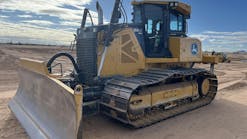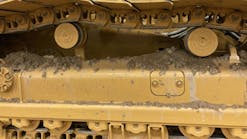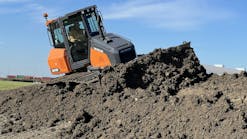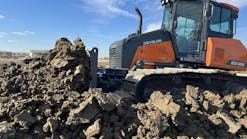Cat D11 Dozer Repower Doubles Machine Life
The first repower of a Caterpillar D11N has been completed in a joint effort between Southern California’s Johnson Caterpillar and the Cat repower team.
The task was to bring the older Cat D11 dozer up from an earlier spec with its unregulated Cat 3508 engine to Tier II emissions. By doing so, the California-based construction company Sukut Construction is able to meet bid requirements in contracts that specify minimum Tier II emissions level on job sites, said Mike Ortiz, equipment president of Sukut Equipment.
Sukut Equipment is a rental company, with more than 250 big machines, that supplies the equipment needs of Sukut Construction, among other clients. Sukut Construction is one of California’s major contractors.
Sukut Equipment’s Cat D11 dozer was an earlier version of the biggest Caterpillar bulldozer. The Cat D11N dozer was first introduced in 1986, powered by a 3508 mechanical Cat at 770 horsepower. It superseded the D10 as the biggest crawler dozer in the Cat product range. Since 2008, the biggest Cat is the D11T, weighing some 230,000 pounds. Ortiz has recently added a new D11T to the fleet and says the price came out at $2.2 million. The repower puts a modern Cat C27 into the engine compartment of the earlier dozer, adding another two decades of life to a tractor that has already worked 20 years. Given the repower, and some other updating to the Cat D11 dozer, the expense is a fraction of the new cost.
“The $350,000 ticket is a very cost-effective way of extending the useful life of the machine, while making it acceptable to bids for environmentally sensitive sites,” said Ortiz.
Sukut Equipment is no stranger to repowers, working in one of the most environmentally conscious states in the nation. But while the California Air Resources Board has backed off somewhat in its draconian off-highway cleanup rules, Sukut had already embarked on an aggressive repower program. Ortiz says that better than 60 percent of its heavy equipment is Tier II or Tier III compliant. The company’s own technicians have become very good at repowering equipment in the field, taking as few as five days to complete the task.
The Caterpillar D11 dozer repower
For this pioneering repower, Sukut enlisted the help of its Caterpillar dealer, Riverside, Calif.,-based Johnson Equipment. Johnson then enlisted the help of Caterpillar’s own Emissions Solutions team. Nevertheless, with additional rework on the machine, it took around a month to complete.
Working with the Caterpillar team ensured that all phases of the project were covered and that engine specs were decided before any wrenches were turned. “That was all part of the due diligence we went through,” said Duane Valantine, service operations manager at Johnson.
The repower process had been in development for a year; it was initiated for another of Johnson’s customers, though Sukut was the first to present the D11 for the work. Because of the age of the Cat D11N dozer, the repower was not to the current D11T’s C32; instead a C27 was matched to the dozer’s driveline.
“The horsepower and torque matching by Caterpillar was also part of the due diligence,” said Valantine. “We wanted to make sure we didn’t over- or under-power the machine. If we had too much, it would tear the machine apart; under-powering would not meet the customer’s performance expectations.”
The ACERT engine is an altogether newer electronic engine than the 3508 it replaces. Significantly, the repower means the D11 puts out 40 percent less NOx and 40 percent fewer particulates, while likely saving as much as 15 percent in fuel consumption. The repower puts an emissions-compliant piece of equipment into the field at a significantly lower price than the $2.2 million of a new D11T, according to Johnson’s Valantine.
To date, Sukut Equipment—headquartered in Santa Ana, Calif.—has repowered 175 machines, says emissions manager Eric Schmidt, swapping out a certain portion as each new Tier Cat engine became available. Most of the repowers were funded by the state’s Carl Moyer program, with Sukut paying between 15 to 35 percent of the average $100,000 cost per large-engine repower.
With this Cat D11 dozer repower, though, there was no state or federal funding. With funding, the engine once removed has to be scrapped. In this case, there was no grant contribution, so Sukut Equipment is retaining the removed 3508.
Sukut Equipment has 250 major pieces of equipment, including the newly delivered D11T and several other Cat D11 dozers, so it has significant experience with the heaviest of the Cat dozers, weighing in excess of 220,000 pounds.
Swapping Cat D11 dozer engines
To make transporting the Cat D11 dozer to Johnson’s shop in Riverside, Calif., possible, the machine was disassembled by Sukut Equipment staff in the field, removing the blade, ripper and so on so only the bare tractor was hauled in to the dealership. Even so, it was a significant permit load.
There the 3508 mechanical engine was removed and the new C27 ACERT (TA) installed. The engine coming out was rated 850 horsepower; the new repower engine going in was a 875.
It was not just a simple swap, even though the engineering and design work had been completed by Cat Emissions Solutions in Peoria.
Much had been pre-planned: As part of this process, the engine power and torque as well as the accessory configuration were determined to make the repower of the machine go as smoothly as possible. Although the Cat D11 dozer swap was a first, Cat has repower packages for more than 70 applications. As this was a new one, considerable time was spent in the design and engineering for as thorough a preparation as possible. And now, while pioneered by Johnson Equipment, the D11 swap is part of the Cat repower lineup.
But since it was a pioneering install, it still needed an experienced team to accomplish, in only a month, a total rebuild and reconfiguring of a D11 into a Tier II machine. According to Johnson’s Valantine, the actual repower took around three weeks, but on this Caterpillar D series dozer the dealer undertook some additional work for Sukut Equipment while the tractor was in the shop.
Valantine says that the Johnson team is a highly motivated, well trained and high-achieving group that can take a project like this through to the end. And the team has been in the making for the past 11 years. Johnson early realized that repower is the most effective way to accommodate both the state of California and its emissions mandate (currently on hold but unlikely to stay that way, he thinks) and the needs of contractors who either cannot get the equipment they need, or want to squeeze the most frame hours out of the equipment they have. Or, as in this case, bring older equipment up to standards required by bid.
“A machine like this D11 may have another 30, 40, 50 years of life left in it. That’s 80,000 hours-plus on the frame, and even that depends on application,” said Valantine. Repowering to meet the bid requirements made much more economic sense than buying another new machine, he said.
The actual installation presented some challenges, but less than may be imagined, said Valantine. With the repower pre-engineered, the Johnson team was able to use many of the brackets and mountings and common components. And, says Valantine, they have top-class fabricators who can turn out a reliable and durable product in a short time.
Two of the challenges were the upgrading of the cooling system and the switch from mechanical to electronic engine controls. The D11 was brought up to the current production cooling system for use with the C32, effectively mirroring the factory system on a new D11 machine and giving additional cooling. And then the electronics on the engine had to be coupled with warning systems and controls on the machine, taking it from the old analog system to a 20-year-later digital system. Both tasks were completed quickly and efficiently, said Valantine, as the team has experienced cooling and electronics technicians.
The repower not only means the D11 is up to bid spec with its 40-percent cleaner NOx and PM emissions, but there’s also a strong likelihood that the 20-year newer technology on the engine will deliver better fuel efficiency, a plus over the extended life of the equipment. Valantine says he is waiting for the field validation, but anticipates it may fall in the range of 15 percent savings.
Sukut’s Ortiz sees this as a great opportunity to extend the life of an expensive piece of equipment. He is under no illusions, though. He can see another repower down the road as California’s rules bite ever deeper. But there’s no doubting that the repower option brings years more compliant life to a machine like the D11. Repowering at one-sixth the cost makes too much economic sense.
For a pioneering repower, the job went well, enabled by the experienced teams, both at Sukut who had stripped the D11 then rebuilt it after the repower, and by the team at Johnson that has gained more than a decade’s experience in Cat repowers.
At the end of the day, it was bigger and heavier than past tasks and there were new challenges to be faced, but having performed the first D11 repower, the Johnson team and Cat Emissions Solutions are ready for more. In fact, they are ready for as many more as the current economic conditions, bid requirements or California regulation can throw at them.
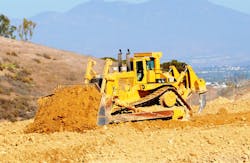
![cat-logo[1] (1) cat-logo[1] (1)](https://img.constructionequipment.com/files/base/ebm/constructionequipment/image/2022/06/1654742824712-catlogo1_1.png?auto=format,compress&fit=crop&q=45&h=139&height=139&w=250&width=250)
